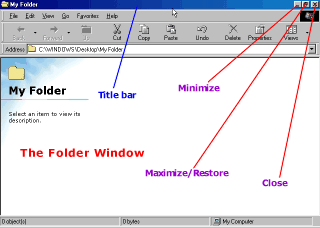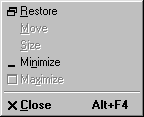
Windows most common Tasks
Every Folder in Windows has the following layout, the figure below is called a window.
The menubar, title bar, and three squares at top right are common to all windows, whether you have a Folder or File.
 OPEN and CLOSE
OPEN and CLOSETo start an application or access a file/folder you have to OPEN, when you finish you should CLOSE. Every single program in Windows has 3 squares at the top right of the screen
The minus is MINIMIZE, suppose you opened two application or files, MINIMIZE allows you to put your first job away for a while and deal with the other, you don't have to put the files back in the drawer, put them aside without closing.
The double-square is Maximize/Restore.
You can maximize the window of your file to fit the entire screen
If you have several files opened, "maximizing" puts them on top of each other so you can see only one file at the top, by "restoring" you will have all the files visible on the desktop just choose one and start working: you can write and draw at the same time very easily. To close anything just press on
Another way of enlarging and reducing the window is a fast double-click on the title bar just 2-click and you can easily switch from fullscreen to normal size.
Suppose you opened two or more windows (file, folder) to see in which one you are working just look at the title bar the highlighted (blue) title bar indicates the active Window, the one you're working with, everything else has a gray title bar showing an inactive window. You can maximize a minimized window by clicking the button on the taskbar, if you have several windows opened, just match the title bar with the name of the button on taskbar.
What's so cool about Windows is that you can move the window and place it wherever you want, it's like moving a piece of paper on your actual desktop but this time with the mouse, just click on the title bar (the Window should not be maximized, if it fits the screen you will not be able to move it -logical !) and Drag. To Drag an item is to click
(left-click) on the title bar, hold then move the mouse. The whole process is called Drag and Drop. You can also move a window (if window is not Max) by r-click on title bar and selecting MOVE, I guess you'll not use this one, since click and DRAG is much easier.
By using the mouse you can even change the size of the window: (not maximized) take the mouse pointer
 Perhaps you've noticed that sometimes a
command turns gray, don't panic this only means that the
following command is disabled so if you click on it
nothing will happen.
Perhaps you've noticed that sometimes a
command turns gray, don't panic this only means that the
following command is disabled so if you click on it
nothing will happen.Suppose you have a maximized window, you cannot maximize anymore, the command maximize turns gray.The gray shade is quite useful, if you're lost or forgot what command to use, you can eliminate some choices, or realize that the command will not
work because you've missed something.
We are always talking about the mouse: clicking and 2-clicking, however this is not the only way to navigate Windows, maybe one day your lovely Cat ate the mouse, what can you do ? well you can use the Keyboard for a while, until you get a new mouse.
If you have several windows opened, you can switch from on window to another by holding ALT and pressing TAB(look on your Keyboard), when you release the TAB button you are switched to the chosen window. We will learn more about using the keyboard as we go through the tutorial. You can arrange your windows on the screen using Cascade and TILE: suppose you have 2 Windows just r-click on Taskbar and select CASCADE WINDOWS, now you have all windows on top of each other with title bars aligned, it's like putting your papers on top of each other with their headers visible, you can also TILE the windows: TILE WINDOWS Horizontal/Vertical.
Suppose you are typing some text and painting an image, If you don't want to switch from one application to another, just select TILE Vertical/Horizontal, both windows will be visible on the screen taking 50% each.
Even tiled windows can be resized easily. To minimize all the windows at the same time, r-click on taskbar and Minimize All Windows. To return to the previous mode just r-click
and select UNDO minimize all